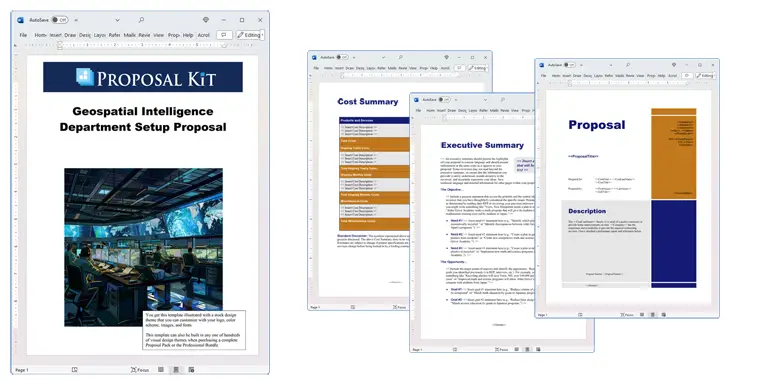How to write your Geospatial Intelligence Department Setup Proposal
We include this 35 page layout with every Proposal Pack. If you want this template to have a different visual design theme than the one illustrated here, purchase any Proposal Pack design and create this template using the purchased design theme. This template is included in every Proposal Pack. If you get a Proposal Pack or the Professional, you can also make any variation of this template with different chapters to suit your needs.
We typically include more chapters in the templates than most people will need to give everyone more variety in the chapters they may need. You can trim down a long template by removing pages you do not need or combining multiple chapter topics into one page.
 DOWNLOADABLE, ONE-TIME COST, NO SUBSCRIPTION FEES
DOWNLOADABLE, ONE-TIME COST, NO SUBSCRIPTION FEESYou can also create countless variations of this document to suit your needs using the included library of 2200+ chapters if ordering a Proposal Pack or Professional.
 What Our Clients Say
What Our Clients SayProposal Kit helped me create a very professional and detailed quote which landed me one of my biggest clients to date! Fantastic value and an affordable price!"
Polarverse
Related Article
Related Video
Related Templates
- Mapping and Satellite Imagery Sales Proposal
- Technology Strategy Analysis
- Technology Consulting Proposal
- Telecommunications Cellular Services Proposal
- Telecommunications RFP Response Proposal
- Defense Contracting Intelligence System Proposal
What's the Best Way to Write Your Geospatial Intelligence Department Setup Proposal?
A proven way to write your geospatial intelligence department setup proposal is using the Proposal Kit template and software package. Proposal Kit provides a comprehensive and structured approach to proposal writing, ensuring you can create a professional and persuasive document even without experience.
Using Proposal Kit, you gain access to an extensive library of templates specifically designed to address the unique needs of setting up a geospatial intelligence department. These templates include pre-formatted sections that guide you through every aspect of your proposal, from the initial cover letter to detailed cost summaries and technical specifications.
Additionally, Proposal Kit incorporates a line item quoting database system, which is invaluable for generating accurate cost summaries, quotes, estimates, budgets, and other financial topics.
What Types of Projects Are Geospatial Intelligence Department Setup Proposals Written For?
Numerous projects may be included when proposing a geospatial intelligence department. Here are some examples.
- Establishing a new Geospatial Intelligence Department for a government agency
- Enhancing data collection and analysis capabilities
- Improving decision-making through geospatial data
- Integrating geospatial systems with existing government systems
- Training government personnel in geospatial technologies
- Upgrading outdated geospatial intelligence infrastructure
- Implementing security measures for sensitive geospatial data
- Managing large datasets efficiently
- Generating actionable insights from geospatial data
- Comparing different geospatial solutions
- Developing a comprehensive project management plan
- Ensuring compliance with government regulations
- Optimizing resource allocation and management
- Enhancing disaster response and management capabilities
- Supporting urban planning and development
- Improving environmental monitoring and analysis
Chapters this template is built with
There is no one-size-fits-all template that will work for all use cases. Here are some essential components that can be customized using Proposal Kit's extensive library of thousands of chapters
By expanding on each of these chapters with specific details relevant to your geospatial intelligence department setup proposal, you can create a comprehensive and engaging document that communicates the value of your offerings. Using Proposal Kit's extensive library of templates, you can customize each section to meet your specific needs and ensure a professional and polished final proposal.
This list of chapter templates is just a small selection of the thousands of templates available in Proposal Kit's template library. You can customize your proposal to cover all necessary topics.
Cover Letter
A cover letter introduces your proposal, setting the stage for the following details. It should briefly state the document's purpose and highlight key points, such as the objective of setting up a geospatial intelligence department for the Office of the Secretary of Defense (OSD) or the National Geospatial-Intelligence Agency (NGA). Mention how your company's expertise aligns with the specific needs of these agencies, providing a reason for them to continue reading.
Problem Statement
This section outlines the problems or challenges the proposed geospatial intelligence department will address. For example, it might detail the need for improved geospatial data analysis to enhance national security or the inefficiencies in current data processing methods. By clearly stating the issues, you help the agency understand the necessity and urgency of the project.
Executive Summary
The executive summary provides a concise overview of the entire proposal, summarizing the key points and making a case for why your proposal should be accepted. This section should highlight the main benefits of your solution, the projected impact on the agency's operations, and a brief overview of the cost and implementation plan.
Proposition
You detail your proposed solution here, explaining how you will set up the geospatial intelligence department and what technologies and methodologies you will use. Describe the step-by-step process of establishing the department, from initial planning to full operational capability, emphasizing advanced GIS systems and data integration techniques.
Cost Summary
A detailed cost summary provides a breakdown of all anticipated expenses. Using Proposal Kit's line item quoting database system ensures accuracy and transparency in your financial projections. Include costs for software, hardware, staffing, training, and other relevant expenses, giving the agency a clear understanding of the financial investment required.
Competitive Analysis
This section compares your proposed solution with alternative approaches, highlighting its unique advantages. For example, you could compare your use of cutting-edge geospatial technologies and your experience with similar projects to the solutions offered by other vendors, emphasizing why your proposal offers the best value.
Goals and Objectives
Clearly define the geospatial intelligence department's goals and objectives, ensuring they align with the agency's priorities. Objectives include improving the accuracy of geospatial data, reducing response times in emergencies, or enhancing interagency data-sharing capabilities.
Advantages
Outline your proposal's benefits and advantages, emphasizing how it will meet the needs of the OSD or NGA. Highlight features such as enhanced data security, improved data processing speeds, and greater accuracy in geospatial analysis that set your proposal apart from others.
Solutions
Detail the solutions you will implement, including any custom software or hardware systems. Describe how these solutions will address the problems identified in the Problem Statement and how they will be integrated into the agency's infrastructure.
Technical Approach
Explain the technical methodologies and processes you will use to set up and operate the geospatial intelligence department. This might include details on the data acquisition methods, the GIS software, and the integration of remote sensing technologies.
Data Management
Describe your data management plan, including how you will handle data storage, processing, and security. Detail the systems and protocols you will use to ensure data integrity and confidentiality and how you will comply with relevant data protection regulations.
Staffing
Provide details on the personnel required for the project, including their roles, qualifications, and how they will be sourced. Mention any specialized skills or certifications needed and how you plan to recruit and retain these key team members.
Safeguards
Explain the security measures you will implement to protect sensitive geospatial data. This might include encryption protocols, secure data storage solutions, and access control mechanisms to ensure that only authorized personnel can access sensitive information.
System Integration
Describe how you will integrate the new geospatial intelligence systems with existing infrastructures. This includes ensuring compatibility with current systems, training staff on new technologies, and establishing seamless data transfer and communication procedures.
Response Time
Outline your strategy for ensuring timely responses to geospatial intelligence needs and emergencies. This might include implementing real-time data processing systems, using automated alerts, and establishing rapid response protocols.
Project Management
Detail your project management approach, including timelines, milestones, and risk management strategies. Describe how you will ensure the project stays on track and within budget and how you will handle any potential challenges that arise.
Security
Emphasize the security protocols and measures to protect geospatial data from unauthorized access and cyber threats. Include details on physical and digital security measures and any compliance with government security standards.
Intelligence
Describe how the geospatial intelligence department will gather, analyze, and disseminate geospatial data. Explain the workflows and tools you will use to ensure accurate and timely intelligence that supports the agency's decision-making processes.
Technology
Detail your technology stack, including software, hardware, and network systems. Highlight proprietary technologies or innovative solutions to enhance the department's geospatial intelligence capabilities.
Infrastructure
Explain the physical and digital infrastructure required for the geospatial intelligence department. This might include data centers, secure facilities, network infrastructure, and other physical assets necessary for the department's operations.
Imagery
Discuss the role of satellite and aerial imagery in your geospatial intelligence operations. Describe how you will acquire, process, and analyze imagery data to support the agency's needs and how this data will be integrated with other geospatial information.
Ecosystem
Describe how your geospatial intelligence department will fit within the larger ecosystem of the agency's operations. Explain how it will interact with other departments, share data, and contribute to the agency's mission.
Specifications
Provide detailed technical specifications for all proposed systems and technologies. This includes hardware requirements, software capabilities, data formats, and other technical details for implementing the geospatial intelligence department.
Recommendations
Offer recommendations for future improvements and upgrades to the geospatial intelligence department. Suggest ways to enhance capabilities, increase efficiency, and ensure the department remains at the forefront of geospatial technology.
Capabilities
Highlight your team's capabilities and proposed systems, emphasizing how they will meet the agency's needs. Provide examples of past successes and demonstrate your ability to deliver high-quality geospatial intelligence solutions.
Past Projects
Showcase past projects that demonstrate your experience and success in similar endeavors. Include case studies, client testimonials, and any relevant metrics that highlight the positive outcomes of your previous work.
Qualifications
Detail the qualifications of your team members and the company as a whole. Include certifications, relevant experience, and other credentials that establish your expertise in geospatial intelligence.
About Us
Provide a comprehensive company overview, including its history, mission, and values. Explain how your company's background and philosophy align with the needs of the geospatial intelligence department project.
Security Clearance
If applicable, detail the security clearances held by your team members. This is particularly important for projects involving sensitive government data and operations.
Comparison Chart
Include a comparison chart that highlights your proposal's advantages over competing bids. Use this chart to show how your solutions are superior in cost, capabilities, and alignment with the agency's needs.
Facilities
Describe the facilities where the geospatial intelligence department will be housed. Include details on the physical security measures, technology infrastructure, and unique features that make your facilities suitable for this project.
Team Members
Introduce the key team members who will be involved in the project. Provide brief bios highlighting their qualifications, experience, and roles within the project to demonstrate your team's strength and capability.
Use cases for this template
Enhancing Data Collection and Analysis Capabilities
Rachel of GeoData Solutions needed to write a proposal to enhance data collection and analysis capabilities for a government agency's geospatial intelligence department. With limited experience in proposal writing, Rachel turned to Proposal Kit for guidance. She began by selecting templates that would best showcase her company's expertise and the strategic advantages of her proposed solutions.
Using the Cover Letter template, Rachel introduced her company and outlined the proposal's objective - enhancing the agency's data collection and analysis capabilities. She followed this with a well-written Problem Statement highlighting the agency's current limitations in data collection and the need for advanced analytical tools.
In the Executive Summary, Rachel provided a concise overview of her proposal, summarizing the benefits of the advanced GIS systems and remote sensing technologies her company would implement. The Proposition section detailed her team's step-by-step process to deploy these technologies, including training and integration phases.
Rachel utilized the Cost Summary template to break down the financial aspects, ensuring transparency and accuracy with Proposal Kit's line item quoting database system. The Technical Approach template allowed her to explain the methodologies and technologies, including cutting-edge software and hardware solutions, to enhance data collection and analysis.
By leveraging these and other templates from Proposal Kit, Rachel created a comprehensive and professional proposal that clearly communicated her vision.
Improving Decision-Making Through Geospatial Data
At Tech Innovators Corp., David was tasked with writing a proposal to improve decision-making using geospatial data for a government geospatial intelligence department. Facing a tight deadline, David turned to Proposal Kit.
David began with the Cover Letter, introducing Tech Innovators Corp. and summarizing the proposal's aim to leverage geospatial data for better decision-making. The Problem Statement clearly defined the existing challenges in the agency's decision-making processes due to inadequate geospatial data integration.
Using the Executive Summary template, David provided a brief overview of his proposal, emphasizing the benefits of improved decision-making capabilities. He used the Proposition section to detail how his company would implement advanced data analytics and visualization tools to enhance the agency's strategic and operational decisions.
The Cost Summary template helped David present a detailed and transparent budget, which included costs for software development, data integration, and training. In the Technical Approach section, he explained his team's methodologies to ensure the seamless integration of geospatial data into the agency's decision-making processes, including AI-driven analytics and real-time data visualization.
David also included a Competitive Analysis to highlight the unique advantages of Tech Innovators Corp.'s approach compared to other solutions. By following Proposal Kit's structured templates and customizing them to fit his specific needs, David produced a compelling and professional proposal that impressed the decision-makers and secured the contract for his company.
Integrating Geospatial Systems with Existing Government Systems
Sophia needed to write a proposal for a government agency to integrate geospatial systems with existing government systems. She turned to Proposal Kit to create a well-organized and persuasive proposal.
Starting with the cover letter, Sophia introduced her company and stated that the goal was to integrate new geospatial systems with the agency's existing infrastructure. The Problem Statement highlighted the current disjointed data systems and the inefficiencies they caused in data management and decision-making.
Sophia provided an overview of her proposal in the Executive Summary, summarizing the benefits of seamless system integration. The Proposition section detailed her team's steps to achieve this integration, including system compatibility assessments, data migration plans, and staff training programs.
The Cost Summary template allowed Sophia to present a detailed budget outlining costs for software, hardware, and personnel required for the integration. In the System Integration section, she described the technical processes her team would use to ensure a smooth and efficient integration of geospatial systems with the government agency's existing infrastructure.
Sophia also included:
- A Project Management section.
- Detailing timelines.
- Milestones.
- Risk management strategies to ensure the project stayed on track.
By using Proposal Kit's comprehensive templates and customizing them to her specific needs, Sophia created a professional and convincing proposal.
Conclusions and Recommendations
Writing a geospatial intelligence department proposal can seem overwhelming, especially for those with little experience. However, with the help of the Proposal Kit, creating a professional and effective document becomes manageable. Proposal Kit offers the tools and templates you need to succeed.
Also Known As
This template may also be referred to in different ways or be used in more specialized situations, such as:
- Geospatial Intelligence Division Establishment Proposal
- GIS Department Formation Proposal
- Spatial Data Intelligence Unit Setup Proposal
- Geospatial Analysis Department Creation Proposal
- Geo-Intelligence Office Development Proposal
- GIS Intelligence Center Implementation Proposal
- Geospatial Intelligence Branch Setup Proposal
- Geospatial Information Services Department Proposal
- Geo-Intelligence Agency Formation Proposal
- Geospatial Data Analysis Department Proposal
Abstract
 Establishing a geospatial intelligence department is an important endeavor for any organization or government agency looking to enhance its analytical capabilities and decision-making processes through geospatial data. This comprehensive guide outlines the effective use of Proposal Kit templates and software to create a proposal. With access to an extensive array of templates, Proposal Kit supports the intelligence community by providing structured guidance on enterprise risk management, technical analysis, and maintenance of geospatial systems. It assists organizations like the National Geospatial-Intelligence Agency (NGA) in planning base operations services and acquiring unclassified commercial geoint products.
Establishing a geospatial intelligence department is an important endeavor for any organization or government agency looking to enhance its analytical capabilities and decision-making processes through geospatial data. This comprehensive guide outlines the effective use of Proposal Kit templates and software to create a proposal. With access to an extensive array of templates, Proposal Kit supports the intelligence community by providing structured guidance on enterprise risk management, technical analysis, and maintenance of geospatial systems. It assists organizations like the National Geospatial-Intelligence Agency (NGA) in planning base operations services and acquiring unclassified commercial geoint products.
By using the Proposal Kit, users can develop detailed documents addressing important components such as cost evaluation, system integration, and data management. This approach ensures proposals align with industry standards while maintaining unclassified networks and providing timely solutions to improve enterprise performance. The customizable templates allow for the adoption of best practices in engineering and project management, ultimately reducing the total cost and enhancing critical capabilities.
Whether the objective is to manage large datasets, improve environmental monitoring, or support urban planning, the Proposal Kit facilitates a seamless proposal creation process. It provides the tools necessary to deliver a responsible and professional document that meets the unique needs of any agency or organization.
 The Proposal Kit serves as an invaluable tool for entities aiming to establish a geospatial intelligence department, offering a structured and systematic approach to proposal development. This resource not only enhances the quality and professionalism of the proposals but also helps users regardless of their previous experience with proposal writing. By using the Proposal Kit, organizations can create documents that assist the National Geospatial-Intelligence Agency (NGA) in addressing their objectives, ensuring that they provide NGA with timely and actionable insights.
The Proposal Kit serves as an invaluable tool for entities aiming to establish a geospatial intelligence department, offering a structured and systematic approach to proposal development. This resource not only enhances the quality and professionalism of the proposals but also helps users regardless of their previous experience with proposal writing. By using the Proposal Kit, organizations can create documents that assist the National Geospatial-Intelligence Agency (NGA) in addressing their objectives, ensuring that they provide NGA with timely and actionable insights.
The templates included in the Proposal Kit are designed to provide support across various stages of proposal development, from articulating the initial concept to detailing follow-on contracts. This structured methodology enables organizations to acquire products and services that align with their operational goals precisely. Furthermore, the Proposal Kit facilitates the seamless integration of advanced geospatial technologies, aiding in the efficient deployment of resources and the maintenance of high-performance standards.
For the target audience, primarily government agencies and large enterprises, the use of Proposal Kit translates to significant time and cost savings. The comprehensive templates ensure that every topic of the proposal is covered, from financial breakdowns to technical specifications, allowing these organizations to make informed decisions. Ultimately, adopting the Proposal Kit for geospatial intelligence proposals enhances the capability of these entities to respond to emerging challenges, optimize data analysis, and foster a collaborative environment that supports sustainable growth and innovation.
 Proposal Kit stands out as an important resource for those seeking to establish or enhance a geospatial intelligence department. Its extensive library of templates simplifies the complex process of proposal writing by offering clear guidance on structuring documents that resonate with decision-makers, such as those within the National Geospatial-Intelligence Agency (NGA). By providing a framework for clear communication, Proposal Kit enables organizations to present their capabilities compellingly and coherently.
Proposal Kit stands out as an important resource for those seeking to establish or enhance a geospatial intelligence department. Its extensive library of templates simplifies the complex process of proposal writing by offering clear guidance on structuring documents that resonate with decision-makers, such as those within the National Geospatial-Intelligence Agency (NGA). By providing a framework for clear communication, Proposal Kit enables organizations to present their capabilities compellingly and coherently.
One of the significant advantages of using Proposal Kit is its ability to assist NGA and similar agencies in navigating the intricacies of follow-on contracts, ensuring continuity and sustained support in operations. The templates allow organizations to provide NGA with precise and comprehensive proposals that encapsulate all necessary information, from goals to technological solutions. This ensures that organizations can provide timely insights and deliverables that meet the specific requirements of the NGA.
Moreover, the Proposal Kit allows entities to showcase their expertise and readiness to address complex geospatial challenges. Offering structured sections for cost analysis, technical solutions, and project timelines equips organizations with the tools needed to assure stakeholders of their ability to manage projects efficiently. This proactive approach helps build trust and credibility, paving the way for long-term partnerships and collaboration with agencies like the NGA. Ultimately, the use of Proposal Kit not only streamlines the proposal process but also enhances the alignment between service providers and government agencies, fostering environments where innovation and excellence in geospatial intelligence can thrive.
Frequently Asked Questions
What is a geospatial intelligence department proposal?
A geospatial intelligence department proposal is a document that outlines the plan, methodologies, and financial details for establishing a geospatial intelligence department or project within an organization or government agency.
How can Proposal Kit help me create a geospatial intelligence department proposal?
Proposal Kit offers a wide range of templates and a software package that simplifies the process of creating professional and effective proposals tailored to your specific needs.
Can I customize the templates in Proposal Kit?
Yes, Proposal Kit's templates are fully customizable, allowing you to tailor the content to meet your needs and preferences.
Is support available for questions while using Proposal Kit?
Yes, Proposal Kit offers customer support to assist you with any questions or issues you may encounter while using their products.
Can I use Proposal Kit for other documents besides proposals?
Absolutely. The Proposal Kit can be used to create various types of business documents, including quotes, estimates, reports, and more.
20% Off Discount
![]() Add To Cart This Word Template
Add To Cart This Word Template
 Add To Cart Proposal Pack for Any Business
Add To Cart Proposal Pack for Any Business
 Add To Cart Proposal Kit Professional
Add To Cart Proposal Kit Professional
 4.7 stars, based on 849 reviews
4.7 stars, based on 849 reviewsProposal Kit chapters used in this template
Cover Letter, Title Page, Table of Contents, Executive Summary, Problem Statement, Solutions, Proposition, Goals and Objectives, Intelligence, Ecosystem, Security, Imagery, Comparison Chart, Advantages, Competitive Analysis, Technology, Technical Approach, System Integration, Response Time, Safeguards, Data Management, Staffing, Facilities, Infrastructure, Project Management, Specifications, Cost Summary, Recommendations, Team Members, Security Clearance, About Us, Qualifications, Capabilities, Past Projects, Back Page
Line Item Automated Chapters
If you purchase a Proposal Pack or the Professional Bundle, these proposal pages are generated using an automated line-item database in the included Wizard software.
Cost Summary
You use this proposal for
- General business proposal
- Technical proposal
- Service sales proposal
- RFP response
- Government contract proposal
- IT, software, hardware proposal
- Security, safety, protection, investigation proposal
How to create this template with Proposal Pack Wizard
You can create this document using any of the logo-designed Proposal Packs. Pick any Proposal Pack with a logo design theme you like best; they will all work equally well. The Proposal Pack for Any Business is the pack with no extra added logos or colors - designed to be used plain or for you to customize with your logos and graphics.
The Proposal Pack design theme you purchase will determine the visual look of this template. The screenshot above only shows the plain generic design theme.
We include a library of chapters to be assembled based on your needs. All proposals are different and have different needs and goals. We designed Proposal Pack so you can customize the documents to suit your needs.
You will best create this document using the Proposal Pack Wizard - Expert Edition software to select this template and build it in the Proposal Pack logo design theme of your choice along with any desired customizations (such as adding additional chapters, removing unneeded chapters, changing the order of chapters, and importing your company logo). This template outlines a proposal for the described situation. Each user is responsible for typing in the actual content of the provided pages with their information to complete the proposal. Suggestions in the abstract may include features in higher-end packages and are facilitated by the selection of chapter templates to support the narrative of each proposal, which help guide the user in filling in the details.
The Wizard software's AI Writer will write the content of the pages of the template based on details provided for your company, client, project, financial details and other writing instructions. This will provide a personalized version of the template completely written and ready to edit.
Once finished, the AI Writer's Word-to-PowerPoint converter can transform your proposal, business plan, or other business documents into a PowerPoint slideshow. Save time and effort by letting the AI analyze every chapter to condense its content into talking points, visually matching the document, and providing a consistent package of presentation material with the click of a button.
You create this template using the Wizard software with an entire Proposal Pack library and software. We include the Expert Edition of the software in the Proposal Kit Professional. Microsoft Word for Windows is required to use the customizing software. You can also edit Word document templates in other office software such as Word for Mac. We will assist Mac users in assembling complex templates for their first project if they do not have the required platform to run the Wizard software.
How to Build Templates Featured on Proposal Kit Website
Many people find the Proposal Kit website after searching for a specific proposal. Once you've purchased and installed the software, how do you build that template you found in the first place? This video shows you how to build any proposal you see on the Proposal Kit website.
 Ian Lauder has been helping businesses write their proposals and contracts for two decades. Ian is the owner and founder of Proposal Kit, one of the original sources of business proposal and contract software products started in 1997.
Ian Lauder has been helping businesses write their proposals and contracts for two decades. Ian is the owner and founder of Proposal Kit, one of the original sources of business proposal and contract software products started in 1997.By Ian Lauder
 Published by Proposal Kit, Inc.
Published by Proposal Kit, Inc.


 Cart
Cart
 Get 20% off ordering today:
Get 20% off ordering today: 


 Facebook
Facebook YouTube
YouTube Bluesky
Bluesky Search Site
Search Site